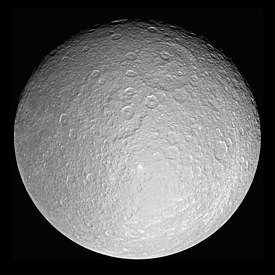Rhea (moon)

Cassini mosaic of Rhea
|
|||||||||
| Discovery | |||||||||
|---|---|---|---|---|---|---|---|---|---|
| Discovered by | G. D. Cassini | ||||||||
| Discovery date | December 23, 1672 | ||||||||
| Designations | |||||||||
| Saturn V | |||||||||
| Adjectives | Rhean | ||||||||
| Orbital characteristics | |||||||||
| 527108 km | |||||||||
| Eccentricity | 0.0012583 | ||||||||
| 4.518212 d | |||||||||
|
Average orbital speed
|
8.48 km/s | ||||||||
| Inclination | 0.345° (to Saturn's equator) | ||||||||
| Satellite of | Saturn | ||||||||
| Physical characteristics | |||||||||
| Dimensions | 1532.4 × 1525.6 × 1524.4 km | ||||||||
|
Mean radius
|
763.8±1.0 km | ||||||||
| 7337000 km2 | |||||||||
| Mass | (2.306518±0.000353)×1021 kg (~3.9×10−4 Earths) | ||||||||
|
Mean density
|
1.236±0.005 g/cm³ | ||||||||
| 0.264 m/s² | |||||||||
| 0.635 km/s | |||||||||
|
4.518212 d (synchronous) |
|||||||||
| zero | |||||||||
| Albedo | 0.949±0.003 (geometric) | ||||||||
|
|||||||||
| 10 | |||||||||
Rhea (/ˈriːə/ REE-ə; Ancient Greek: Ῥέᾱ) is the second-largest moon of Saturn and the ninth-largest moon in the Solar System. It is the second smallest body in the Solar System, after the asteroid and dwarf planet Ceres, for which precise measurements have confirmed a shape consistent with hydrostatic equilibrium. It was discovered in 1672 by Giovanni Domenico Cassini.
Rhea was discovered by Giovanni Domenico Cassini on 23 December 1672. It was the third moon discovered around Saturn and the second by him.
Rhea is named after the Titan Rhea of Greek mythology, the "mother of the gods". It is also designated Saturn V (being the fifth major moon going outward from the planet).
Cassini named the four moons he discovered (Tethys, Dione, Rhea and Iapetus) Sidera Lodoicea (the stars of Louis) to honor King Louis XIV. Astronomers fell into the habit of referring to them and Titan as Saturn I through Saturn V. Once Mimas and Enceladus were discovered, in 1789, the numbering scheme was extended to Saturn VII.
...
Wikipedia
